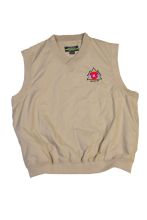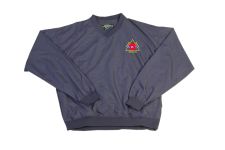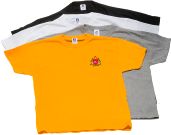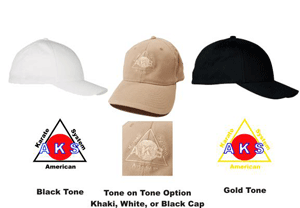
|

|
|
Online Edition: 51 March 2016 |
The Master's Edge 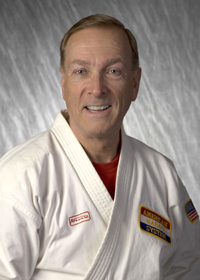
Michael A. Sullenger
9th Dan AKS Chief Instructor . . . |
|
|||||||||||||||||||||||||||||||||||||||||||||||||||||||||||||||||||||||||||||||||||||||||||||||||||||||||||||||||||||||||||||||||||||||||||||||||||||||||||||||||||||||||||||||||||||||||||||||||||||||||||||||||||||||||||||||||||||||||||||||||

Frederic A. Reinecke
8th Dan AKS . . . |
Looking Toward the FutureAssistant Chief Instructor American Karate System It seems like most karateka I talk to all have the same complaint. Karate is dying and there doesn't seem to be much we can do about it. I have to admit, I sometimes have these same feelings. Well I can't worry about all the other styles of karate. I really am only concerned with the AKS. Last Punchline I tried to give everyone some tips on how to Market their clubs. Remember, sales drives the world and if you're not selling, you must be standing still. I mentioned making a business card to promote the class or club that you belong to and train with. Let's send some of these finished cards into Laura so that they get published in the newsletter. Hopefully inspiring others to create their own club business card. Of course we have to do more than just those basic marketing tips. In recent conversations with my Phys-Ed Boss at Muskegon Community College, and also with a young black belt from a different style, they both mentioned to me (not a unique idea), but something I really hadn't given much thought. Change the way we talk about what we do. A rebranding so to speak. If you don't know branding, here is the definition: "The marketing practice of creating a name, symbol or design that identifies and differentiates a product from other products." An effective brand strategy gives you a major edge in increasingly competitive markets. At one time, the concept of the AKS was a brand unto itself. Unfortunately, many other styles placed the word American in front of their style name and American Karate System became just another type of karate in the eyes of the uninitiated. So even though we don't really want to change how we practice karate, we need to change how we talk about it. We also need to change how we present it to our communities. Now I know, as a style, we started out to be eclectic in our thought processes. We were going to make the AKS an American Karate, not hindered by the stuffy traditions pushed by the Asians styles. Unfortunately, as I look at our style, we have become the stuffy traditionalist. We are as traditional or more traditional than most of what I call traditional styles. Some of this is ok, I really don't want to throw the baby out with the bath water. Here are some "Branding" ideas that we can talk about as we move forward:
Lastly, I would remind everyone that these are only suggestions to think about. Even if we only implement a couple of the ideas listed above, we wouldn't be any worse off. Don't be afraid of change. Don't be afraid to think outside of the box (tradition). Keep training hard, and talk up these ideas with your club mates. Hopefully this generates some conversation at our annual summer camp. Which will keep our dream alive.
|
|||||||||||||||||||||||||||||||||||||||||||||||||||||||||||||||||||||||||||||||||||||||||||||||||||||||||||||||||||||||||||||||||||||||||||||||||||||||||||||||||||||||||||||||||||||||||||||||||||||||||||||||||||||||||||||||||||||||||||||||||
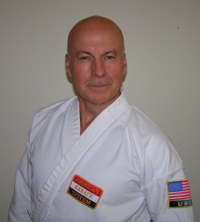
Mark Soderstrom
2nd Dan AKS . . . |
"Luke, Go with Your Attitude cuz Feelings Lie"Assistant Instructor Muskegon Karate Club You may have heard it said, "Give honor unto whom honor is due." Honor. Hmmm . . . That is not something we do well in this century. It was not too long ago that people bowed and curtsied to each other. I am old enough that I remember being taught how to bow in school... how to say yes sir, and yes ma'am.... and yes, children . . . they did have cars then. When was the last time someone showed you honor or you showed honor to someone else? That is, showed honor outside of a Karate class? We show honor in class regularly. I am honored that students ask me questions and that Black Belts will sacrifice their time to teach me. Because the requirements of training sometimes requires close physical contact, sometimes we are not particularly fond of other karate class members. For example, "Why do we always have to do what they want! Well, I suppose sometimes they do what we want but . . . we are always taking care of them! What? . . . Okay, well . . . yes, sometimes they teach us. But they hurt us . . . Okay, sometimes we hurt them too but . . . " Yes, sometimes we can't stand them. However, if someone outside our class says anything against them, you know we will come out fighting. It sounds a lot like a family doesn't it? We fight, mope, and then eventually after the hurts heal, we come back together or at least we should. And yes, sometimes, dad with his 8 stripes has to say . . . "Don't make me come over there." Just like in a family. Family is our goal. At three in the morning when the baby is crying and you are throwing up, you do not feel like getting up and taking care of that child. At that point, you do not feel love for the child, but you do get up, because the child is family. You put on an attitude of love, even when you do not feel it. When we pass on, the family continues. At AKS, we are a part of something much bigger. It goes on, in part, because of honor. When we do not "feel" like "liking" someone, we continue to show them honor. That is an attitude not a feeling. If I went with Obi-Wan's wisdom to go with my feelings, I would weigh 500 pounds and be in jail. I love ice cream and I know way too many people that need to be punched in the nose. However, our founder frequently referred to attitude. Honor your family by forgiving them even when they do not ask for forgiveness. This is an attitude of honor. Each class member and instructor deserves honor. It holds us together. In honoring them, we honor our family and our founder, and the family continues. The family grows. I am proud to know each one of you. Thank you for honoring me, by reading this.
Do You Have Member News ?Please send news (weddings, births, graduations, etc.) so that we may share with our members and friends. Accompanying pictures are most welcome!
If you have a concern, question or suggestion, please let us know and we will address it here in the Punchline.
We look forward to hearing from you ! |
|||||||||||||||||||||||||||||||||||||||||||||||||||||||||||||||||||||||||||||||||||||||||||||||||||||||||||||||||||||||||||||||||||||||||||||||||||||||||||||||||||||||||||||||||||||||||||||||||||||||||||||||||||||||||||||||||||||||||||||||||
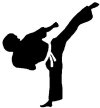
. . . |
PROMOTIONS!!
|
Congratulations to all students who have been promoted this past quarter, and to those we've missed in prior newsletters. Attention Instructors, if you have students who have been promoted, please send this information so that we may acknowledge their accomplishments.
|
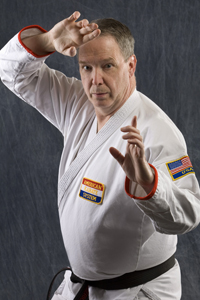
Dave Thomas
8th Dan AKS . . .
|
"Karate Makes Me Happy"American Karate Club - Muskegon, MI Some years ago Mr. Lieb hosted a training seminar in which Master Tadashi Yamashita was the guest instructor. The local media came to interview Sensei Yamashita, who at the time was making feature length movies and television shows. During the course of his interview, he explained karate's influence on his life and he summed it by telling the reporter "Karate makes me happy." I found this statement elegant in its simplicity and profound in its depth of meaning. Over the years, I have often pondered that statement and the depth of its implication. The term "happy" is replete with definitions. And there are many aspects in life, which can make us "happy." But for karate practitioners I believe his assertion has special significance. Endorphins -The first and most obvious form of elation in karate is through physical exercise. When we work out the brain releases endorphins, which heighten our sense of joy and exhilaration. There have been times when I was too tired or had a bad day and I thought I would skip class, but reluctantly I would go anyway. I noticed that after class I always felt better both emotionally and physically. I tell my students to come to class especially on the bad days, karate is great exercise and stress relief, and they will feel better by the end of class than before they came in. Fraternity - In karate, those we train with often become our closest friends. When we walk on the floor there are bows, handshakes and even hugs in tandem with warm greetings. We have a bond of shared goals and experiences, which connects us as a very close-knit group. I tell new students that if they will come to class and train hard they will be accepted as members of our AKS family; a family that supports and nurtures each member without exception. This connection transcends time and distance, it is always exciting to meet or hear from a fellow AKS member even though months or years have passed. Friends - I have seen strangers meet on the dojo floor and quickly become close friends. Common interests, common goals and shared experiences can make steadfast friends of us all. Most of my closest friends are AKS students and Black Belts. The security of having a true friend you can trust and confide in is immeasurable; they know you will be there for them as well. Freedom from fear - I joined karate in my late teens, because I was tired of being afraid. Fear of verbal threats that might escalate to physical assault is a painful way to live. But as I trained, I gained the confidence in my skills and techniques, which diminished those fears. Karate gave me the have the confidence to walk down the street and not have to look at each stranger as a potential threat. The years of training took away the fear and replaced it with appropriate circumspection, and made me a more confident and a happier person. Personal growth - When students join our class, we tell them that by training in karate they will learn self-discipline, improve their self-confidence and develop a better and more accurate self-image. For the students that stay and train, this intrinsic personal growth follows the kicks, punches and katas. It is practically unavoidable. It is usually about green belt level when you can tell that this student actually begins to like himself or herself better as a person. The growth and joy come from the accomplishment of learning the many aspects of martial arts. Teaching - As students get the opportunity to teach beginners, almost always they tell me how much they enjoyed the opportunity to share their knowledge. Instructing students perpetuates our style and helps us become better instructors. It is very gratifying to watch a student execute precise movements and personally rewarding to know we made a contribution to their learning values that will impact the rest of their lives. Spiritual growth - As karatekas learn and grow, their personal and ethical beliefs often taken on deeper conviction. With time, all of attributes previously discussed strengthen their personal choices and values. Because of your accomplishments in karate, you have the confidence to achieve whatever goals you may set for your self. Self-confidence and strength in principles are life-long qualities. Long term this may be the most important part of our contribution to our students. I am sure there are more elements of happiness than I have listed here, but Sensei Yamashita said it best "Karate makes me happy." This article was previously published in our September 2008 Punchline.
|

. . .
|
| ||||||||||||||||||||||||||||||||||||||||||||||||||||||||||||||||||||||||||||||||||||||||||||||||||||||||||||||||||||||||||||||||||||||||||||||||||||||||||||||||||||||||||||||||||||||||||||||||||||||||||||||||||||||||||||||||||||||||||||





